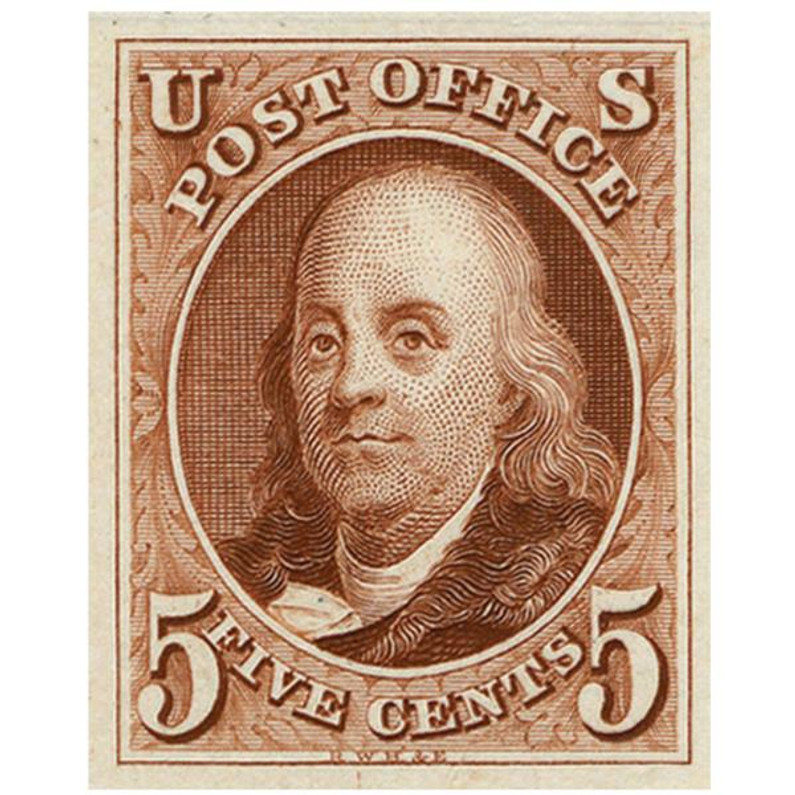AMERICA'S FIRST POSTAGE STAMP- SCOTT #1- 5c RED BROWN BENJAMIN FRANKLIN
America’s First Postage Stamps In the 1840s, United States postal authorities were carefully watching the world’s reaction to Great Britain’s Penny Black, the first adhesive postage stamp. An adhesive stamp was being considered for use in the U.S. When Robert H. Morris, postmaster of New York, proposed issuing a provisional stamp, there were no objections. Morris assumed the printing cost, and in 1845, the first U.S. postmaster’s provisional was issued. Other postmasters followed suit, providing their own distinct stamps for pre-payment of mail. Two years later, the U.S. Post Office Department tried its own government-issued stamp. Rates were determined by the weight and distance the letter was being mailed. Letters mailed a distance of 300 miles or less were 5¢ per half ounce, while those mailed over 300 miles were 10¢ per half ounce. Postage could be paid by the sender at the time the letter was mailed, or by the addressee upon receipt. When postage was paid by the sender, the letter was marked “paid” by pen and ink or hand stamped. If no such cancel was evident, the person receiving the letter paid the postage. Before postage stamps were introduced, inspections for accuracy and records of postal revenues were virtually impossible. When adhesive stamps came on the scene, accurate records could be kept of how many were issued and sold. However, it wasn’t until 1855 that the use of postage stamps became mandatory. A contract was awarded to a firm of bank note engravers for the printing of the 5¢ and 10¢ stamps. The stamps were to be available in major post offices on July 1, 1847. Due to delays in production, only one office, New York City, received the stamps on that date. The stamps were produced until 1851. Reproductions (official imitations) of both stamps were printed by the Bureau of Engraving and Printing. (They were invalid for postage.) Differences from originals include: Line of the mouth is straighter, eyes appear “sleepy,” engraver’s initials at bottom of stamps are fainter. these stamps were isued in 1875 in conjuction with Philadelphia's 1876 Centennial Exposition. They are listed in the Scott Catalogue as #3 and #4, imperforate, on bluish paper with no gum. Issued: July 1, 1847 Printed by: Rawdon, Wright, Hatch & Edison Method: Flat plate in sheets of 200 subjects each Quantity Printed: 3,600,000 (estimate) Watermark: None Perforation: Imperforate Color: Red brown The “Father” of the American Postal Service is pictured on the first U.S. postage stamp. Inventor, philosopher, statesman, diplomat, author, and scientist, Benjamin Franklin is credited with organizing America’s postal service in the 1700s. Appointed by the British Crown as a deputy postmaster, he greatly improved service to major cities. In 1775, he was appointed as the first Postmaster General. Under his direction, the new Continental Post Office played an important role in the Revolution.The 1847 stamp features an engraving which also appeared previously on banknotes.
Recent Posts
-
US PINBACK FOREVER STAMPS SEND A WHIMISICAL COLORFUL GREETING ON LETTERS
Since their first appearance in 1896, pinback buttons have expressed viewpoints, made statements and …Feb 14th 2025 -
NEW AUSTRIA STAMP PROMOTES CONSERVATION & RECYCLING WITH POSTAL UNIFORMS!!
When a piece of clothing becomes a stamp: in the spirit of sustainability, used Austrian Post unifor …Jan 17th 2025 -
THIS NEW YEAR CHERUB PARTIED HIS WAY ONTO A US STAMP IN 2000!
The "New Year Cherub" is a popular motif often used in holiday decorations, greeting cards, and art. …Jan 3rd 2025




